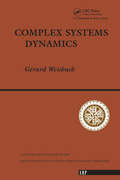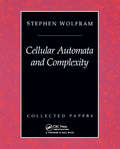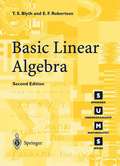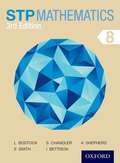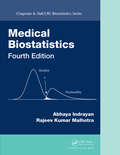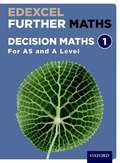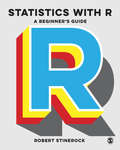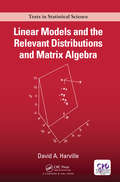- Table View
- List View
Algebraic Topology: A First Course
by Marvin J. GreenbergGreat first book on algebraic topology. Introduces (co)homology through singular theory.
The Mathematics Of Generalization: Proceedings: Sfi-cnls Workshop On Formal Approaches To Supervised Learning (1992: Santa Fe, N. M.)
by David. H WolpertThis volume grew out of a workshop designed to bring together researchers from different fields and includes contributions from workers in Bayesian analysis, machine learning, neural nets, PAC and VC theory, classical sampling theory statistics and the statistical physics of learning. The contributions present a bird's-eye view of the subject.
The Art Of Probability: For Scientists And Engineers
by Richard W. HammingOffering accessible and nuanced coverage, Richard W. Hamming discusses theories of probability with unique clarity and depth. Topics covered include the basic philosophical assumptions, the nature of stochastic methods, and Shannon entropy. One of the best introductions to the topic, The Art of Probability is filled with unique insights and tricks worth knowing.
Real Variables (Pure And Applied Mathematics Ser. #Volume 123)
by Alberto TorchinskyA modern introduction to the theory of real variables and its applications to all areas of analysis and partial differential equations. The book discusses the foundations of analysis, including the theory of integration, the Lebesque and abstract integrals, the Radon-Nikodym Theorem, the Theory of Banach and Hilbert spaces, and a glimpse of Fourier series. All material is presented in a clear and motivational fashion.
Numerical Analysis
by Donald GreenspanFirst Published in 2018. Routledge is an imprint of Taylor & Francis, an Informa company.
Complex Systems Dynamics
by Gerard WeisbuchFirst Published in 2018. Routledge is an imprint of Taylor & Francis, an Informa company.
Algebraic Topology: A First Course (Contemporary Mathematics Ser. #Vol. 58)
by Marvin J. GreenbergGreat first book on algebraic topology. Introduces (co)homology through singular theory.
Primary Mathematics: Knowledge and Understanding
by Claire Mooney Alice Hansen Lindsey Davidson Sue Fox Reg WrathmellSecure subject knowledge and understanding is the foundation of confident, creative and effective teaching. To help your students master this, the 8th edition of this established text now comes with a range of online resources: Interactive Maths subject knowledge audit: to assess your students' overall performance and ensure they have an accurate picture of their ability. Reflective self-assessment questions: to help consolidate students’ understanding of each chapter topic and monitor their learning as they work through the book. Glossary: building students' knowledge of tricky terminology. Covering the whole primary curriculum, this edition also includes updated interactive activities throughout the book to engage students in their learning and enable discussion. Using this book in conjunction with the free online resources really makes this the complete package for developing Mathematics subject knowledge.
Nonlinear Dynamics, Mathematical Biology, And Social Science: Wise Use Of Alternative Therapies
by Joshua M. EpsteinThese lectures develop simple models of complex social processes using nonlinear dynamics and mathematical biology. Dynamical analogies between seemingly disparate social and biological phenomena,revolutions and epidemics, arms races, and ecosystem dynamics,are revealed and exploited. Nonlinear Dynamics, Mathematical Biology, and Social Science invites social scientists to relax,in some cases abandon,the predominant assumption of perfectly informed utility maximization and explore social dynamics from such perspectives as epidemiology and predator-prey theory. The volume includes a concentrated course on nonlinear dynamical systems.
Hydrodynamic Fluctuations, Broken Symmetry, And Correlation Functions
by Dieter ForsterFrom the Preface: "The purpose of this book is to present and apply a language and to discuss methods which make it very convenient to exploit such analogies, and which are uniquely suited to describe and explain non-equilibrium phenomena in a rich variety of many-particle systems: the language of time correlation functions and linear response theory."
Cellular Automata And Complexity: Collected Papers
by Stephen WolframAre mathematical equations the best way to model nature? For many years it had been assumed that they were. But in the early 1980s, Stephen Wolfram made the radical proposal that one should instead build models that are based directly on simple computer programs. Wolfram made a detailed study of a class of such models known as cellular automata, and discovered a remarkable fact: that even when the underlying rules are very simple, the behaviour they produce can be highly complex, and can mimic many features of what we see in nature. And based on this result, Wolfram began a program of research to develop what he called A Science of Complexity."The results of Wolfram's work found many applications, from the so-called Wolfram Classification central to fields such as artificial life, to new ideas about cryptography and fluid dynamics. This book is a collection of Wolfram's original papers on cellular automata and complexity. Some of these papers are widely known in the scientific community others have never been published before. Together, the papers provide a highly readable account of what has become a major new field of science, with important implications for physics, biology, economics, computer science and many other areas.
Hydrodynamic Fluctuations, Broken Symmetry, And Correlation Functions (Frontiers in Physics)
by Dieter ForsterFrom the Preface: "The purpose of this book is to present and apply a language and to discuss methods which make it very convenient to exploit such analogies, and which are uniquely suited to describe and explain non-equilibrium phenomena in a rich variety of many-particle systems: the language of time correlation functions and linear response theory."
Cellular Automata And Complexity: Collected Papers
by Stephen WolframAre mathematical equations the best way to model nature? For many years it had been assumed that they were. But in the early 1980s, Stephen Wolfram made the radical proposal that one should instead build models that are based directly on simple computer programs. Wolfram made a detailed study of a class of such models known as cellular automata, and discovered a remarkable fact: that even when the underlying rules are very simple, the behaviour they produce can be highly complex, and can mimic many features of what we see in nature. And based on this result, Wolfram began a program of research to develop what he called A Science of Complexity."The results of Wolfram's work found many applications, from the so-called Wolfram Classification central to fields such as artificial life, to new ideas about cryptography and fluid dynamics. This book is a collection of Wolfram's original papers on cellular automata and complexity. Some of these papers are widely known in the scientific community others have never been published before. Together, the papers provide a highly readable account of what has become a major new field of science, with important implications for physics, biology, economics, computer science and many other areas.
Mathematical Foundations of Quantum Mechanics: New Edition
by John Von Neumann Robert T. Beyer Nicholas A. WheelerQuantum mechanics was still in its infancy in 1932 when the young John von Neumann, who would go on to become one of the greatest mathematicians of the twentieth century, published Mathematical Foundations of Quantum Mechanics--a revolutionary book that for the first time provided a rigorous mathematical framework for the new science. Robert Beyer's 1955 English translation, which von Neumann reviewed and approved, is cited more frequently today than ever before. But its many treasures and insights were too often obscured by the limitations of the way the text and equations were set on the page. In this new edition of this classic work, mathematical physicist Nicholas Wheeler has completely reset the book in TeX, making the text and equations far easier to read. He has also corrected a handful of typographic errors, revised some sentences for clarity and readability, provided an index for the first time, and added prefatory remarks drawn from the writings of Léon Van Hove and Freeman Dyson. The result brings new life to an essential work in theoretical physics and mathematics.
Sets, logic and maths for computing (PDF)
by David MakinsonThis book equips the student with essential intellectual tools that are needed from the very beginning of university studies in computing. These consist of abilities and skills - to pass from a concrete problem to an abstract representation, reason with the abstract structure coherently and usefully, and return with booty to the specific situation. The most basic and useful concepts needed come from the worlds of sets (with also their employment as relations and functions), structures (notably trees and graphs), and combinatorics (alias principles of counting, with their application in the world of probability). Recurring in all these are two kinds of instrument of proof – logical (notably inference by suppositions, reductio ad absurdum, and proof by cases), and mathematical (notably induction on the positive integers and on well-founded structures). From this book the student can assimilate the basics of these worlds and set out on the paths of computing with understanding and a platform for further study as needed.
Basic Linear Algebra (PDF)
by T. S. Blyth E. F. RobertsonBasic Linear Algebra is a text for first year students leading from concrete examples to abstract theorems, via tutorial-type exercises. More exercises (of the kind a student may expect in examination papers) are grouped at the end of each section. The book covers the most important basics of any first course on linear algebra, explaining the algebra of matrices with applications to analytic geometry, systems of linear equations, difference equations and complex numbers. Linear equations are treated via Hermite normal forms which provides a successful and concrete explanation of the notion of linear independence. Another important highlight is the connection between linear mappings and matrices leading to the change of basis theorem which opens the door to the notion of similarity. This new and revised edition features additional exercises and coverage of Cramer's rule (omitted from the first edition). However, it is the new, extra chapter on computer assistance that will be of particular interest to readers: this will take the form of a tutorial on the use of the "LinearAlgebra" package in MAPLE 7 and will deal with all the aspects of linear algebra developed within the book.
STP Mathematics 8 Student Book
by Sue Chandler Linda Bostock Ewart Smith Ian BettisonThis third edition of the best-selling STP Mathematics series provides all the support you need to deliver the 2014 KS3 curriculum. These student books retain the authoritative and rigorous approach of the previous editions, whilst developing students' problem-solving skills, helping to prepare them for the highest achievement at KS4. Kerboodle resources are also available which include additional assessment activities, online digital versions of the student books and comprehensive teacher support.
Medical Biostatistics, Fourth Edition (Chapman & Hall/CRC Biostatistics Series)
by Abhaya Indrayan Rajeev Kumar MalhotraEncyclopedic in breadth, yet practical and concise, Medical Biostatistics, Fourth Edition focuses on the statistical aspects ofmedicine with a medical perspective, showing the utility of biostatistics as a tool to manage many medical uncertainties. This edition includes more topics in order to fill gaps in the previous edition. Various topics have been enlarged and modified as per the new understanding of the subject.
Edexcel A Level Further Maths. Further Decision 1 Student Book
by David Bowles Eddie Mullan David Baker Brian Jefferson John Rayneau Mark Rowland Robert Wagner Paul Williams Garry Wiseman Katie Wood Mike HeylingsThis Student Book provides full support for the Decision Maths 1 paper in the Edexcel AS and A Level exams. Throughout the book, the explanations are clear and concise, with an emphasis on visual presentation, abundant worked examples and learning by doing. In every chapter, sequential exercises allow students to practise first their fluency and skills, and then the new exam-style problem-solving and modelling questions. The problem-solving is supported by Strategy boxes, which provide guidance on how best to approach these questions. Short answers are given in the back, while full step-by-step solutions to every single question can be found online. This Student Book belongs to a series of 10 OUP Student Books covering all the compulsory and optional papers for Edexcel Further Maths AS and A Level.
Differential Equations with Applications and Historical Notes (Textbooks in Mathematics)
by George F. SimmonsFads are as common in mathematics as in any other human activity, and it is always difficult to separate the enduring from the ephemeral in the achievements of one’s own time. An unfortunate effect of the predominance of fads is that if a student doesn’t learn about such worthwhile topics as the wave equation, Gauss’s hypergeometric function, the gamma function, and the basic problems of the calculus of variations—among others—as an undergraduate, then he/she is unlikely to do so later. The natural place for an informal acquaintance with such ideas is a leisurely introductory course on differential equations. Specially designed for just such a course, Differential Equations with Applications and Historical Notes takes great pleasure in the journey into the world of differential equations and their wide range of applications. The author—a highly respected educator—advocates a careful approach, using explicit explanation to ensure students fully comprehend the subject matter. With an emphasis on modeling and applications, the long-awaited Third Edition of this classic textbook presents a substantial new section on Gauss’s bell curve and improves coverage of Fourier analysis, numerical methods, and linear algebra. Relating the development of mathematics to human activity—i.e., identifying why and how mathematics is used—the text includes a wealth of unique examples and exercises, as well as the author’s distinctive historical notes, throughout. Provides an ideal text for a one- or two-semester introductory course on differential equations Emphasizes modeling and applications Presents a substantial new section on Gauss’s bell curve Improves coverage of Fourier analysis, numerical methods, and linear algebra Relates the development of mathematics to human activity—i.e., identifying why and how mathematics is used Includes a wealth of unique examples and exercises, as well as the author’s distinctive historical notes, throughout Uses explicit explanation to ensure students fully comprehend the subject matter Outstanding Academic Title of the Year, Choice magazine, American Library Association.
Statistics with R: A Beginner's Guide (PDF)
by Robert StinerockThe dynamic, student focused textbook provides step-by-step instruction in the use of R and of statistical language as a general research tool. It is ideal for anyone hoping to: Complete an introductory course in statistics Prepare for more advanced statistical courses Gain the transferable analytical skills needed to interpret research from across the social sciences Learn the technical skills needed to present data visually Acquire a basic competence in the use of R. The book provides readers with the conceptual foundation to use applied statistical methods in everyday research. Each statistical method is developed within the context of practical, real-world examples and is supported by carefully developed pedagogy and jargon-free definitions. Theory is introduced as an accessible and adaptable tool and is always contextualized within the pragmatic context of real research projects and definable research questions. Author Robert Stinerock has also created a wide range of online resources, including: R scripts, complete solutions for all exercises, data files for each chapter, video and screen casts, and interactive multiple-choice quizzes.
Linear Models and the Relevant Distributions and Matrix Algebra (Chapman & Hall/CRC Texts in Statistical Science)
by David A. HarvilleLinear Models and the Relevant Distributions and Matrix Algebra provides in-depth and detailed coverage of the use of linear statistical models as a basis for parametric and predictive inference. It can be a valuable reference, a primary or secondary text in a graduate-level course on linear models, or a resource used (in a course on mathematical statistics) to illustrate various theoretical concepts in the context of a relatively complex setting of great practical importance. Features: Provides coverage of matrix algebra that is extensive and relatively self-contained and does so in a meaningful context Provides thorough coverage of the relevant statistical distributions, including spherically and elliptically symmetric distributions Includes extensive coverage of multiple-comparison procedures (and of simultaneous confidence intervals), including procedures for controlling the k-FWER and the FDR Provides thorough coverage (complete with detailed and highly accessible proofs) of results on the properties of various linear-model procedures, including those of least squares estimators and those of the F test. Features the use of real data sets for illustrative purposes Includes many exercises David Harville served for 10 years as a mathematical statistician in the Applied Mathematics Research Laboratory of the Aerospace Research Laboratories at Wright-Patterson AFB, Ohio, 20 years as a full professor in Iowa State University’s Department of Statistics where he now has emeritus status, and seven years as a research staff member of the Mathematical Sciences Department of IBM’s T.J. Watson Research Center. He has considerable relevant experience, having taught M.S. and Ph.D. level courses in linear models, been the thesis advisor of 10 Ph.D. graduates, and authored or co-authored two books and more than 80 research articles. His work has been recognized through his election as a Fellow of the American Statistical Association and of the Institute of Mathematical Statistics and as a member of the International Statistical Institute.
AQA A Level Maths: Year 1/AS Student Book (PDF)
by Paul Williams Robert Wagner David Baker Brian Jefferson Mark Rowland John Rayneau Eddie Mullan Katie Wood Gary WisemanThis Student Book has been approved by AQA and provides full support for both AQA's new linear AS Level specification, and for the first year of the full A Level course. Covering all the pure maths, mechanics and statistics content needed, the book provides dedicated exercises in every chapter for exam-style problem-solving and modelling questions. Dedicated revision exercises test synoptically across the curriculum. Throughout the book, the explanatory text isclear and concise, with abundant worked examples to show how key techniques can be used and common pitfalls to avoid. Short answers are in the back of the book, while full step-by-step solutions areprovided online. MyMaths links appear at the bottom of all exercises, providing a quick route to further practice and support.
Primary Mathematics: Teaching Theory and Practice
by Claire Mooney Mary Briggs Alice Hansen Ms Judith McCullouch Mike FletcherAn extensive knowledge of the primary Mathematics curriculum is not enough for trainee teachers, they need to know how to teach Maths in the primary classroom. This is the essential teaching theory and practice text for primary Mathematics that takes a focused look at the practical aspects of teaching. It covers the important skills of classroom management, planning, monitoring and assessment and relates these specifically to primary Maths, with new material on assessment without levels. And to support students even further with the very latest strategies in classroom practice, this 8th edition now includes online resources: Practical lesson ideas for the classroom The Primary National Curriculum for Mathematics in Key Stages one and two Tips for planning primary Mathematics Useful weblinks for primary Mathematics teaching
An Introduction to Analysis
by Robert C. GunningAn essential undergraduate textbook on algebra, topology, and calculusAn Introduction to Analysis is an essential primer on basic results in algebra, topology, and calculus for undergraduate students considering advanced degrees in mathematics. Ideal for use in a one-year course, this unique textbook also introduces students to rigorous proofs and formal mathematical writing--skills they need to excel.With a range of problems throughout, An Introduction to Analysis treats n-dimensional calculus from the beginning—differentiation, the Riemann integral, series, and differential forms and Stokes's theorem—enabling students who are serious about mathematics to progress quickly to more challenging topics. The book discusses basic material on point set topology, such as normed and metric spaces, topological spaces, compact sets, and the Baire category theorem. It covers linear algebra as well, including vector spaces, linear mappings, Jordan normal form, bilinear mappings, and normal mappings.Proven in the classroom, An Introduction to Analysis is the first textbook to bring these topics together in one easy-to-use and comprehensive volume.Provides a rigorous introduction to calculus in one and several variablesIntroduces students to basic topologyCovers topics in linear algebra, including matrices, determinants, Jordan normal form, and bilinear and normal mappingsDiscusses differential forms and Stokes's theorem in n dimensionsAlso covers the Riemann integral, integrability, improper integrals, and series expansions





